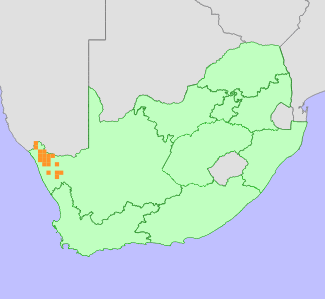|
Scientific Name | Conophytum stevens-jonesianum L.Bolus |
Higher Classification | Dicotyledons |
Family | AIZOACEAE |
Synonyms | Conophytum pageae (N.E.Br.) N.E.Br. var. pygmaeum (Schick & Tischer) Rawé |
National Status |
Status and Criteria | Endangered A4cd |
Assessment Date | 2021/12/09 |
Assessor(s) | A.J. Young, I. Ebrahim, D. Guo, A. Harrower, L. Jabar, L. Knoetze, C. Rodgerson, P.C.V. Van Wyk, N.N. Mhlongo & P.G. Desmet |
Justification | This species is endemic to the Northern Cape province of South Africa where it has an extent of occurrence (EOO) of 12,671 km2 and an area of occupancy (AOO) of 288 km2. The population is in decline due to illegal collection for the international trade in ornamental succulents since 2019. Illegal collection is likely to increase as there has been a dramatic increase in the number of species and volume of plants targeted since 2019 including many from the immediate area. The continued threat of illegal collection is therefore regarded as very high for this particular species. Whilst this species is highly sought after by collectors, the scattered distribution of individual or small colonies of plants across a relatively broad and often remote area is suspected to limit the decline to 50-60% of the population within the next three generations (90 years). Climate change is also impacting the population and is suspected to cause a decline of 42% of the population by 2080. It therefore qualifies as Endangered under criterion A4. |
Distribution |
Endemism | South African endemic |
Provincial distribution | Northern Cape |
Range | This dwarf succulent species is endemic to the Northern Cape province of South Africa. |
Habitat and Ecology |
Major system | Terrestrial |
Major habitats | Kosiesberg Succulent Shrubland, Bushmanland Inselberg Shrubland, Umdaus Mountains Succulent Shrubland, Southern Richtersveld Inselberg Shrubland, Central Richtersveld Mountain Shrubland, Namaqualand Klipkoppe Shrubland, Stinkfonteinberge Eastern Apron Shrubland, Lekkersing Succulent Shrubland, Anenous Plateau Shrubland, Namaqualand Blomveld, Western Gariep Hills Desert, Southern Nababiepsberge Mountain Desert, Kahams Mountain Desert |
Description | This small succulent species is found in the Succulent Karoo and Desert biomes, predominantly within the Richtersveld and Gariep Desert bioregions but also Namaqualand Hardeveld and Southern Namib Desert bioregions. It is very widespread and is found in 18 separate vegetation units. The plants are typically found on granite, often in grit-filled shallow weathered depressions, generally in the open where they are exposed to full sun.
This species has a generation length of 30 years. It is expected to be sensitive to the impacts of climate change as it does not disperse and while adapted to arid conditions, is dependent on limited seasonal rainfall. Species in the genus are sensitive to long periods of drought. Drought related mortality has been observed for other closely related taxa within the genus. |
Threats |
| This species is currently threatened by illegal collection for the international trade in ornamental succulents. This is likely to increase in future as there has been a dramatic increase in the number of species and volume of plants targeted since 2019. This species has become increasingly popular in cultivation in recent years. The scattered distribution of mature individuals across a remote landscape may serve to limit losses to 50-60% of the population over three generations (90 years).
Anthropogenic climate change is a long-term threat to this species. Loss of vegetation cover has been observed across the geographic range occupied by this species via Landsat imagery between 1984 and 2018 indicating a decline in habitat quality. Climate models for the likely emission scenarios where emissions stay at present day levels (RCP 2.6) (Hausfather and Peters 2020) and worst case scenarios where emissions continue to increase during the 21st century (RCP 8.5) indicate that there will be a loss of suitable bioclimatic envelope of between 62% and 96% by 2080 for this species. However, as this species possesses certain morphological traits likely to afford resilience to xerophytic conditions and is found across several vegetation units it is expected to have a level of resilience to climate change and the expected population loss is reduced by 20% to 42%. Species in this genus have limited dispersal ability and migration to suitable habitats elsewhere is regarded as highly unlikely. |
Population |
Plants are typically found as scattered individuals or just a few mature individuals across the landscape. There are no formal estimates of population size for this species but there are likely to be between 150,000 and 300,000 mature individuals. The population is in decline due to illegal collection for the ornamental succulent plant trade. At least 1,500 plants have been removed from habitat between 2019 and the end of 2021 based on confiscation records, with many more having likely been removed but not intercepted by law enforcers.
|
Population trend | Decreasing |
Assessment History |
Taxon assessed |
Status and Criteria |
Citation/Red List version | | Conophytum stevens-jonesianum L.Bolus | Least Concern | Raimondo et al. (2009) | |
Bibliography |
Hammer, S. 2002. Dumpling and his wife: New view of the genus Conophytum. EAE Creative Colour, Norwich.
Hammer, S.A. 1993. The genus Conophytum: A conograph. Succulent Plant Publications, Pretoria.
Hausfather, Z. and Peters, G.P. 2020. Emissions - the 'business as usual' story is misleading. Nature 577(618-620).
Opel, M.R. 2004. The rediscovery of Crassula alcicornis. Haseltonia 10:38-40.
Raimondo, D., von Staden, L., Foden, W., Victor, J.E., Helme, N.A., Turner, R.C., Kamundi, D.A. and Manyama, P.A. 2009. Red List of South African Plants. Strelitzia 25. South African National Biodiversity Institute, Pretoria.
Snijman, D.A. 2013. Plants of the Greater Cape Floristic Region 2: The extra Cape flora. Strelitzia 30. South African National Biodiversity Institute, Pretoria.
|
Citation |
| Young, A.J., Ebrahim, I., Guo, D., Harrower, A., Jabar, L., Knoetze, L., Rodgerson, C., Van Wyk, P.C.V., Mhlongo, N.N. & Desmet, P.G. 2021. Conophytum stevens-jonesianum L.Bolus. National Assessment: Red List of South African Plants version 2024.1. Accessed on 2025/11/07 |
 Comment on this assessment
Comment on this assessment


